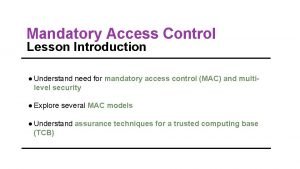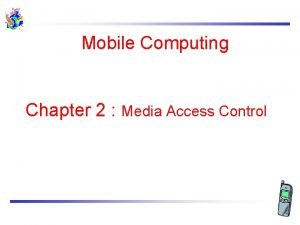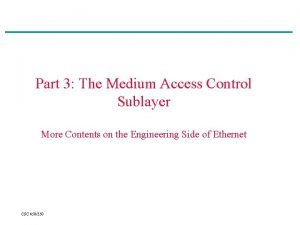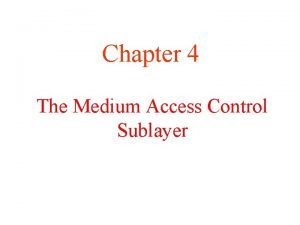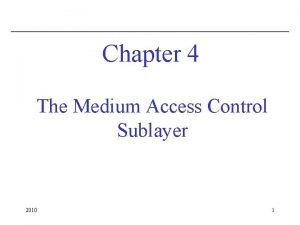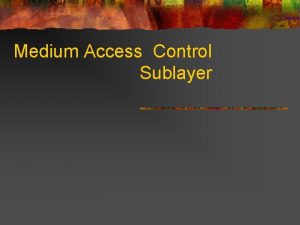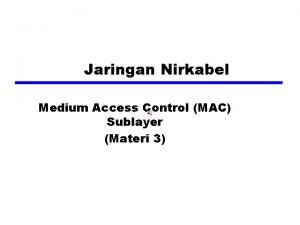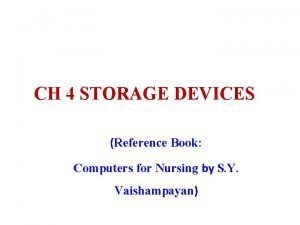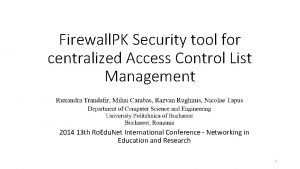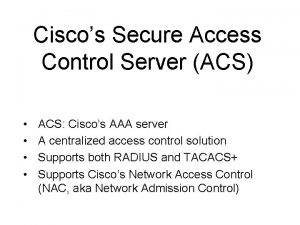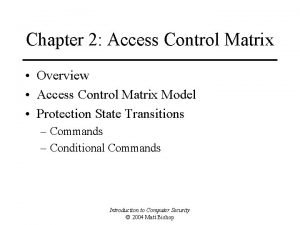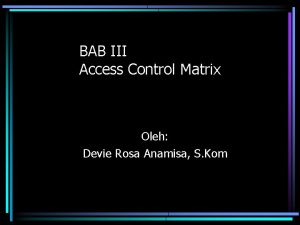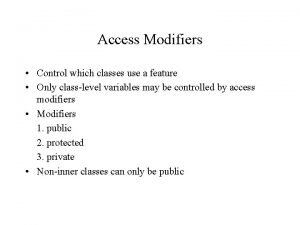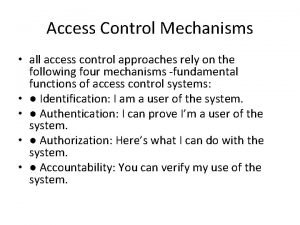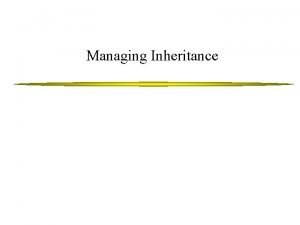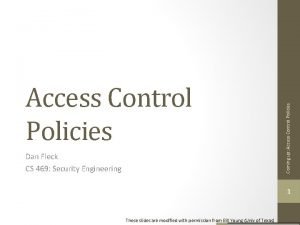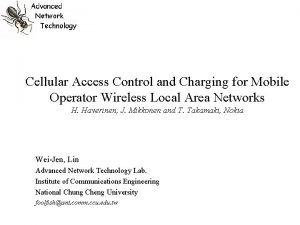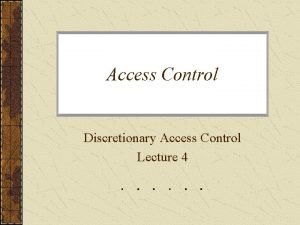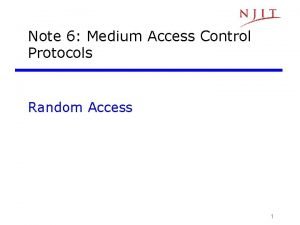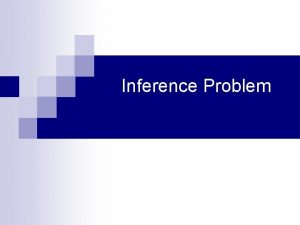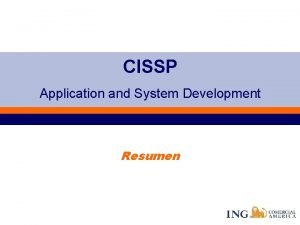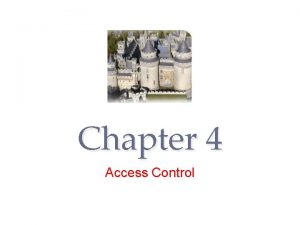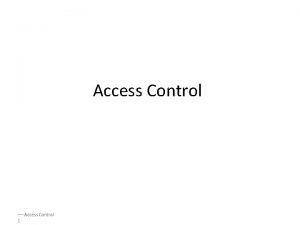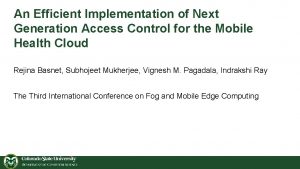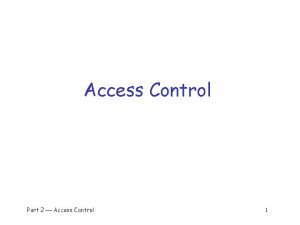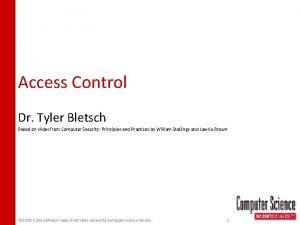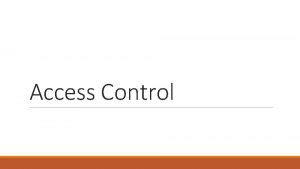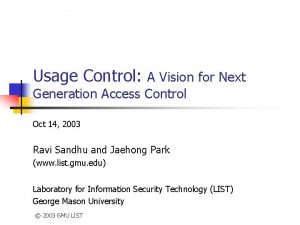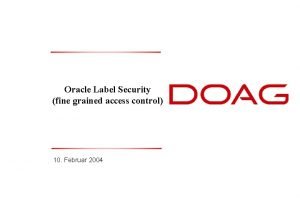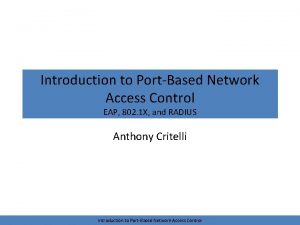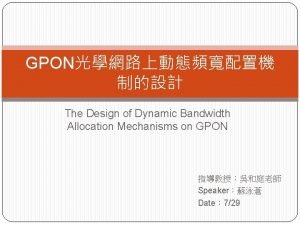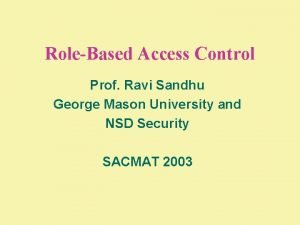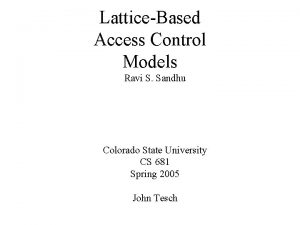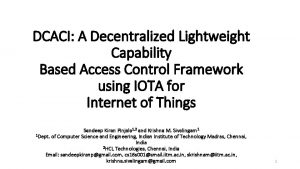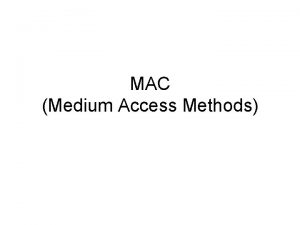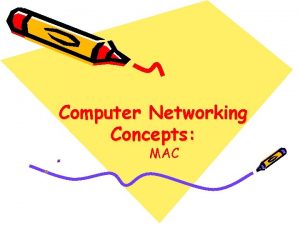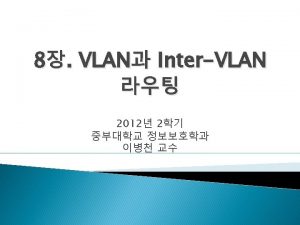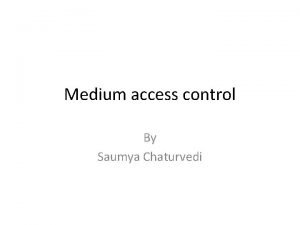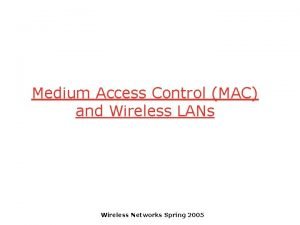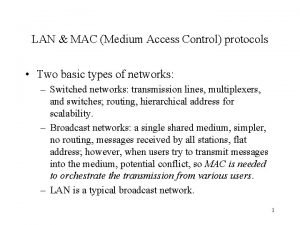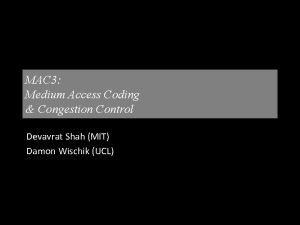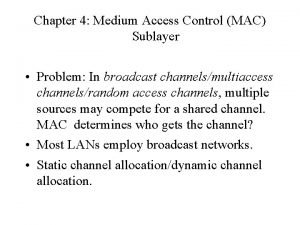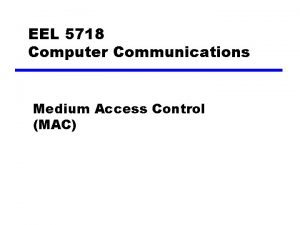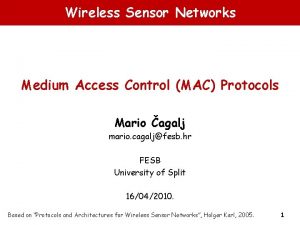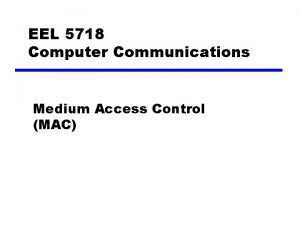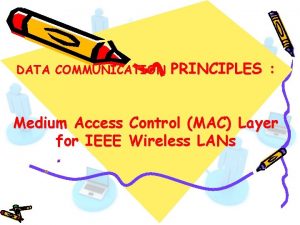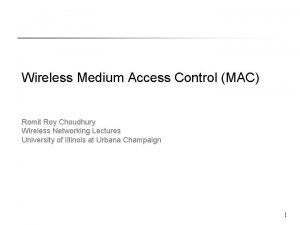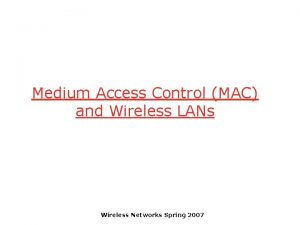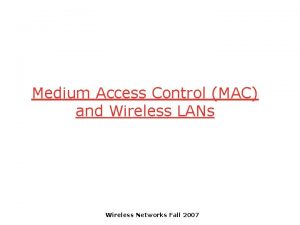Medium Access Control MAC MAC Medium Access Control



































































- Slides: 67

Medium Access Control (MAC)

MAC • Medium Access Control (MAC) is concerned about broadcast channel, also known as multiaccess channels and random access channels. – multiple sources may compete for a shared channel. Two properties: • When one station transmits, anyone can hear (something) • When more than station transmit, collision (data lost) – Example: classic Ethernet, current Wi. Fi. • The issue is to determine who gets the channel. – In a point-to-point link, this problem does not exist. • A point-to-point protocol (e. g. Sliding-window protocol) can run on top of the MAC layer.

A simple MAC protocol • The simplest: – Get data, send immediately. • But, what if there is collision? – Immediately resend? – Wait for a constant time and resend? • This works. Is it good enough? – There is a performance issue. We want a protocol that is fair to all stations while achieving as high a throughput as possible. • High load: high throughput (frames need to be able to get through). • Low load: low delay (don’t want long arbitration).

ALOHA • Each station sends when data is available. • Each station can detect if the frame it sent collided with frames from other stations. If yes, wait for a random time, resend.

ALOHA • What is the performance likely to be? • In other words, if we plot a curve where the x axis is the offered load and y axis is the throughput, how would you expect it to be?

ALOHA • What is the performance likely to be? • In other words, if we plot a curve where the x axis is the offered load and y axis is the throughput, how would you expect it to be? – At low traffic load, everything will get through. – At high traffic load, very few frames can get through.

Slotted ALOHA • Time is divided into slots and each station sends at the beginning of time slots. • Intuitively, why this is better? – Because at least nodes are trying to coordinate with each other. • Can we do even better than that? – What other coordination can you do?

Beyond Aloha – Carrier Sense Protocols • CSMA – Carrier Sense Multiple Access • Listen before send, a basic courtesy • Why call it carrier?

Carrier Sense • 1 -persistent – Station listens to the channel, if busy, waits until idle and send immediately. If collision, waits for a random time and starts over again. • Better than ALOHA because at least if someone is sending, won’t send • Problems – Two stations wait for channel to be idle and will send at the same time – If propagation delay is long, B does not know A has started sending

Carrier Sense • Non-persistent – If no one else is sending, send. Else, wait for a random time and check the channel again. – Does not constantly monitor the channel, so reduces the chance for collision • p-persistent – For slotted channel – If channel is idle, send with probably p, defers to next slot with probably q = 1 -p (try again) – If no idle, wait for next slot and try again

CSMA with Collision Detection • CSMA/CD – Improves CSMA by listening to the channel and abort immediately when there is a collision.

Collision-free protocols • bit-map method. – control frame contain N bits, each station send 1 bits to indicate whether it has a frame to send – at the end of the control frame, every station knows all the station that want to send, the station can send in order. – example: station 0 1 2 3 0123 sync 0 1 frame 3 sync 1 0 0 0 frame 0 – Performance: • At high load: channel efficiency: d/(d+1). • At low load: an average of N/2 for the previous control frame and another N bits for the current control frame. Channel efficiency: d/(d+N)

Collision free protocol • Binary countdown – Each station sends the address bits in some order (from highest order bit to the lowest order bit). – The bits in each position from different stations are ORed. – As soon as a station sees that a high-order bit position that is 0 is overwrite by 1, it gives up. – Eventual, only one station (with largest station number among all the competitors) gets the channel. – example: station 2 (0010) 0 (give up) station 4 (0100) 0 (give up) station 9 (1001) 1 0 0 (give up) station 10 (1010) 1 0 (finished address, send data) OR 1 0 – Performance: • channel utilization rate: d/(d+log(N)) for high load • log(N) bits delay for low load. • Contention field can serve as the address field.

Collision free protocols • Token pass – There is only one token in the network – The token is passed through every node in the network. – Only the node that has the token can transfer data.

Limited Contention Protocols • Collision based protocols (ALOHA, CSMA/CD) are good when the network load is low. • Collision free protocols (bit map, binary countdown) are good when load is high. • Can we combine their advantages -- limited contention protocols? – Behave like the ALOHA scheme under light load – Behave like the bitmap scheme under heavy load.

Limited contention protocol • adaptive tree walk protocol – trick: partition the group of station and limit the contention for each slot. • Under light load, every one can try for each slot like aloha • Under heavy load, only a small group can try for each slot • How do we do it? – treat stations as the leaf of a binary tree. – first slot (after successful transmission), all stations (under the root node) can try to get the slot. – if no conflict, fine. – if conflict, only nodes under a subtree get to try for the next one. (depth first search)

Adaptive tree walk: an example 0 2 1 3 A 4 B C* 6 5 D E* F* G H* Slot 0: C*, E*, F*, H* (all nodes under node 0 can try), conflict slot 1: C* (all nodes under node 1 can try), C sends slot 2: E*, F*, H*(all nodes under node 2 can try), conflict slot 3: E*, F* (all nodes under node 5 can try), conflict slot 4: E* (all nodes under E can try), E sends slot 5: F* (all nodes under F can try), F sends slot 6: H* (all nodes under node 6 can try), H sends.

Adaptive tree walk • Low load: like Aloha • High load? What is the channel efficiency without collision detection? – Can improve by searching at level i (instead of from the root) using the estimated number of stations that want to send.

Classic Ethernet

Classic Ethernet (802. 3) • Physical layer – Shared medium: one machine sends, all can hear. More than one machine sends, collision. – Thick Ethernet: cable like a garden hose – Thin Ethernet: smaller, shorter, more flexible cable – Design for 3 -10 Mbps – Using repeaters to allow multiple segments – No more than 4 repeaters and 2. 5 km between any pair of transceivers.

Ethernet (802. 3): MAC • 1 -persistent CSMA, CD, and binary exponential backoff • Carrier sense: station listens to channel first. 1 -persistent: If idle, station may initiate transmission • Collision Detection: continuously monitor channel and if collision, abort transmission immediately. • A transmitting station detects more energy than it sends, considers a collision, and sends a jam signal to warn others • If collision, when to resend? – To determine the back-off time, use binary exponential backoff : • Each time slot is 51. 2 us (How does this number relate to the Ethernet Spec? 10 Mbps, 2500 meters, 4 repeaters? ) • First collision, retransmission interval = random number between [0, 1] • Second collision, interval = random number between [0, 3] • kth collision, interval = random number between [0, 2 k-1] • upper bound 1023 slots. • Give up after a maximum number of tries.

Why binary exponential backoff • Why not pick a random number from a fixed interval? • Why a fixed small interval not good? • Why a fixed large interval not good?

Binary exponential backoff • The binary exponential backoff is basically how a station uses locally observed information to infer the state of the network and to take the best actions.

802. 3 http: //www. erg. abdn. ac. uk/users/gorry/course/lan-pages/csma-cd. html

Problem • In an Ethernet, suppose there are three stations very close to each other, A, B and C. Suppose at time 0, all of them have a frame to send, but the medium is busy. After the medium is free (for the inter-frame gap, 9. 6 us in some Ethernet), A, B, and C will all send, which results in a collision. They will perform the binary exponential back-off algorithm. What is the probability that the next transmission is again a collision? a) b) c) d) 2/3. 3/4. 5/8. None of the above.

Problem • In an Ethernet, suppose the medium is currently busy, and there are three stations A, B, C, each with exactly one frame to send. When all three frames are sent successfully, which of the following statements is true? a) b) c) d) There were at least 2 collisions. There were at most 3 collisions. There were at least 3 collisions. None of the above.

Ethernet Frame Format (a) DIX Ethernet, (b) IEEE 802. 3

Minimum Frame Size • DIX Ethernet frame size ranges from 64 bytes to 1526 bytes. • For channel efficiency, do we want large or small frames? • Why minimum frame size for Ethernet (64 bytes) ?

Minimum Frame Size • Why a minimum frame size is needed? – Ethernet thinks that a frame goes through if there is no collision. – The key is that you should be still transmitting when being aware of the collision, because if you finished before the collision, when the collision notifying signal comes, you might think it is for some other people’s frame. • How long does it take for a station to make sure that there won’t be any collision?

Worst case

Minimum Frame Size • So, if maximum one-way delay is t, the minimum frame size should be at least 2 t * bit_rate. • 2 t is about 50 us (2500 m + 4 repeaters) • So the minimum frame size of 10 M Ethernet is 512 bits. • What if the speed goes up? E. g. 100 Mbps Ethernet?

Minimum Frame Size • What if the speed goes up? 100 Mbps Ethernet? – Two options: reduce network size, increase minimum size – 100 Mbps Ethernet: 200 m instead of 2500 km

Problem • Hypothetically, suppose it turns out that there cannot be more than 8 stations in any Ethernet. Which of the following statement is true? a) The minimum size of the Ethernet frame can be significantly reduced. b) The back-off algorithm should be modified. c) Both of the above. d) None of the above.

Wireless LAN 802. 11 (Wi. Fi)

Wire LANs 802. 11 • Started in the mid 1990’s • Goal: connecting laptops to the Internet • Operates in unlicensed bands and not (expensive) licensed spectrum • Environmental concerns – Radio signals affected by the weather – Signals bounce off of objects resulting reception following multiple paths and fading of the signal • Bandwidth ! – – 802. 11 b: rates up to 11 Mbps 802. 11 g : rates up to 54 Mbps (OFDM modulation scheme introduced) 802. 11 n: 300 Mbps 802. 11 ac: 7, 000 Mbps

Two modes of operation • Using an Access Point which connects to the (wired) internet • As an Ad Hoc network communicating with other mobile devices without an access point.

Properties of wireless communications (. vs. wired LANs) • When a station is sending, it cannot hear other stations – No collision detection – A station can only do either sending or receiving, but not both.

Properties of wireless communications • Signal decays very fast with the distance – Received signal is much fainter than the transmitted signal. – When a station is sending, you cannot assume all stations can hear the medium is busy. A B C

Properties of wireless communications • If received signal having power P means that you can decode the data, it may be true that at power P/2 you can realize that there is something going on – Being able to sense the carrier does not mean that you can decode the data

Properties of wireless communications • The received signal can be decoded if the signal to noise ratio is larger than a certain threshold. – You may allow two transmissions at the same time without collision. A A->B, C->D B C D A B C A->B, D->C D

Properties of wireless communications • Capture effect – A and C both send to B, B may be able to decode A A B C

Hidden terminal problem A B C D When A transmits to B, A is hidden from C. Suppose C is transmitting to D. Since C is hidden from A, if A decides to transmit to B then A’s transmission would interfere with C’s transmission (to D) at B. But A has no way to know this. So any protocol for transmission must be cognizant of this.

Exposed terminal problem A B C D Assume B is transmitting to A. If C want to transmit to D there is actually no problem doing so. But C hears B’s transmission and believes it should wait until B is finished. B is exposed to C. There is really no reason it should wait. So any protocol for transmission must be cognizant of this also.

Issues with CSMA/CD in Wi. Fi – Hidden channel problem – Sensing the channel cannot guarantee a packet goes through – Collision is more costly with no CD mechanism (want to reduce collision as much as possible).

Multiple Access with Collision Avoidance • MACA was developed by Karn in 1990, and solves some of these problems. Suppose station A wants to transmit to station B. – Sender stimulates the receiver to send a packet. – A first sends a Request to Send (RTS) packet to B. This is a short packet of 30 bytes. It also contains the length of the data frame that will follow. Any station within range of A waits enough time for the response from B to get back to A. – B replies to the RTS by sending a Clear to Send (CTS) if B does not hear anyone else that is transmitting in B’s range. The reply also contains the length of the data frame that A wishes to send. Any station within range of B’s CTS must remain silent through the upcoming data transmission from A to B.

Actions of various stations under MACA C A RTS B D E C hears A’s RTS and wait until A should get the CTS. After that it is free to transmit since C did not hear B’s reply and hence will not interfere with B’s reception. E does the same but also hears the reply and waits until A’s data frame is sent. D does not hear the RTS but as soon as it hears the CTS it waits until A’s data frame is sent. Note however that if both C and B send an RTS to A these will collide. Since neither hears a CTS back both wait a random time and retry. C A CTS E B D

802. 11 MAC protocol: CSMA/CA • Two modes: – DCF (distributed coordination function): used widely. – PCF (point coordination function): AP like a central controller. Not often used in practice. • CSMA with Collision Avoidance – Hidden channel problem – Sensing the channel cannot guarantee a packet goes through – Collision is more costly with no CD mechanism (want to reduce collision as much as possible).

802. 11 DCF MAC protocol • Ideal 1: The sender cannot be certain that a packet is delivered by sensing the channel. • Use ACK. – Sender cannot detect collision, use ACK to make sure. – After sending a packet, the station would expect an ACK. If no ACK is received, it assumes the packet is lost, do MAC layer retransmission.

802. 11 MAC protocol: CSMA/CA • Idea 2: A station waits when the medium is busy. When the medium becomes free, wait for a random amount of time to avoid collision. – Details: A station waits if the medium is busy. When the medium becomes free, select a random backoff counter (e. g. 0 to 15 slots). Decrement the counter every time slot. If the counter reaches 0 and the medium is still free, send the frame. If the counter is still not 0 when the medium becomes busy again, freeze the counter until the medium is free.

Idea 3: Virtual Sensing • So far, we have essentially sensed if the channel is idle / busy by actually seeing if anyone is transmitting. This is called physical sensing. • We can also sense if the channel is idle / busy by virtual sensing which simply means we know by information in some previous frame sent how long the channel is to be busy by the next frame. • This is by tracking the NAV (Network Allocation Vector). Each frame sent has a NAV field that says how long is the exchange sequence associated which this frame. For example, a data frame NAV would include the time needed to send an ack. DIFS data frame SIFS NAV ac k

Sending a frame with CSMA/CA – Basic Channel Acquisition DIFS Busy DIFS Idle Busy Idle Data Ack Wait for idle channel Defer until contention period which is after idle channel and interframe spacing Contention period. Choose backoff number of slots. Count down slots (say 10) when channel is idle. Transmit data frame and get ack

802. 11 MAC protocol: CSMA/CA • Optional: RTS/CTS (request to send/clear to send) • Let’s say A wants to send to B. 1. A sends RTS. 2. If B receives the RTS, it sends CTS. 3. If A receives the CTS, it sends the data packet. 4. If B receives the data packet, it sends the ACK. • It helps with the hidden terminal problem because any station that can cause problems to B should hear the CTS, which includes the transmission length information and should stay quiet. • Does not always work well.

Using RTS & CTS DIFS A: RTS SIFS B: CTS SIFS A: data frame SIFS B: Ack NAV in RTS frame: remaining time NAV in CTS frame: remaining time

802. 11 DCF • What should we do if a packet is lost? – Meaning that we did not get ACK for this packet? • Try again, but doubling the contention window size. – Currently in 802. 11, if a packet is lost, CW = CW * 2. – CWMin = 31. CWMax = 1023. CW is reset to CWMin after every successful transmission.

802. 11 Qo. S: Interframe Spacing • Five different Interframe interval are defined each longer than the previous. – SIFS (short interframe spacing): this is when you need the channel as soon as possible and need to send a control frame or the next fragment of a frame. Also used for ACKs, CTS, etc. – AIFS 1 (arbitration interframe space 1): for sending a high-priority frame – DIFS (DCF interframe spacing): normal spacing for any station to contend for the next frame to be sent. – AIFS 4 (arbitration interframe space 4): for sending a low-priority frame – EIFS (extended interframe spacing): bad frame or reporting a problem • Exact values depend on the version of 802. 11. Also, other names are sometimes used for the AIFs. SIFS AIFS DIFS AIFS EIFS

802. 11 DCF • Slot time – – 802. 11 b, 20 us 802. 11 a, 9 us 802. 11 g, 9 us (fast slot time) 802. 11 n, 9 us (fast slot time) • SIFS: – – 802. 11 b, 10 us. 802. 11 a, 16 us. 802. 11 g, 10 us. 802. 11 n, 10 us in 2. 4 G and 16 us in 5 G • DIFS = SIFS + 2*SLOT

Exercise • Assume there are three stations in a Wi-Fi network all within each other’s communication range. If the medium was busy when they received data from the upper layer. After the medium has been free for DIFS, what will happen? a) b) c) d) All three stations will transmit immediately which will result in a collision. All three stations will wait for others to transmit first. All three stations will pick random numbers to backoff but may still collide with each other. None of the above.

Exercise • Suppose we run a new MAC protocol for Wi-Fi in which the AP polls each station round-robin. Here, polling means that the AP sends a polling message to a station and the polled station will send data if it has data and will send a NULL message if not. Which of the following statements is true? a) b) c) d) It will never achieve higher efficiency than 802. 11 DCF. It may achieve higher efficiency than 802. 11 DCF in some cases. It will always achieve higher efficiency than 802. 11 DCF. None of the above.

Exercise • Suppose a Wi-Fi network has three nodes, A, B, and C, each with exactly one frame to send to the Access Point (AP). Suppose A and B received the data from their upper layers at the same time when the AP was transmitting, and A successfully grabbed the medium after the AP finished transmitting. Suppose C received the data from its upper layer after A started transmitting. Which of the following statements is true? a) b) c) d) B will have a higher probability to transmit than C after A finishes. B and C will have an equal probability to transmit after A finishes. B and C will transmit at the same time after A finishes which will be a collision. None of the above.

Some points • Can a Wi-Fi device know its packet collided with another packet? • Yes, sometimes. – When it finds the medium busy after its own transmission

A few points • Can a Wi-Fi device know the channel is actually not too bad? • Yes, sometimes. – When it finds ACK signal is very strong • Channel is reciprocal – Cannot determine if the signal is not very strong

A few points • Can a Wi-Fi device know there is a hidden terminal? • Yes, sometimes. – When it receives some dataless-ACK, i. e. , an ACK with no data packet before it – Means there is someone transmitting the data packet but I cannot detect it

Rate Adaptation • Wireless nodes may have different channels, some strong, some weak. • Which rate should you choose? Higher data rate requires stronger channels. You should select a rate that most suitable for your channel. • If you select a rate that is above the channel can take, the Packet Error Ratio is going to be high.

Rate Adaptation • Rate adaptation is not part of the 802. 11 standard. • Commonly implemented in the device driver.

Rate Adaptation • Algorithm 1. Maintains a current data rate. – If 10 consecutive packets are good, send a packet as sample at a higher data rate. • If 2 consecutive samples are good, jump to a rate higher – If 3 consecutive packets are lost, reduce the data rate.

Rate Adaptation • Salient features of Algorithm 1: – If channel becomes better, will eventually jump to higher rates – If channel becomes worse, will reduce rate pretty quickly – In other words, will make sure the link is operative

Rate Adaptation • Wi-Fi devices have inherent difficulties to do rate adaptation – The protocol does not have support for channel state feedback (newer ones have) – So, have to rely on the loss statistics • There are more than one possible causes of packet loss, i. e. , bad channel, collision, hidden terminal • The protocol does not provide a mechanism to allow the sender to learn the cause of loss, although the receiver may know it
 Mac media access control
Mac media access control Mandatory access control (mac)
Mandatory access control (mac) Near and far terminals in mobile computing
Near and far terminals in mobile computing Medium access control sublayer
Medium access control sublayer Medium access sub layer
Medium access sub layer Medium access control sublayer
Medium access control sublayer The real macbeth
The real macbeth Mac mac o kok dac
Mac mac o kok dac Hot media and cold media example
Hot media and cold media example Vydj
Vydj Terminal access controller access control system plus
Terminal access controller access control system plus Terminal access controller access-control system
Terminal access controller access-control system Universal access mac
Universal access mac Medium access sublayer
Medium access sublayer Medium access sublayer
Medium access sublayer Channel allocation problem in data link layer
Channel allocation problem in data link layer Medium access sublayer adalah
Medium access sublayer adalah Optical storage
Optical storage Unified access control
Unified access control Stanley pac software manual
Stanley pac software manual Secure server access
Secure server access Keepcoding login
Keepcoding login Nac remediation
Nac remediation Integrated security corporation
Integrated security corporation Access control matrix
Access control matrix Centralized access control
Centralized access control 1997
1997 Alcea alwin
Alcea alwin Volo cloud based access control
Volo cloud based access control Secure access control server
Secure access control server Originator controlled access control
Originator controlled access control An access control matrix
An access control matrix Media access control methods
Media access control methods User access matrix adalah
User access matrix adalah Which modifier is used to control access to critical code
Which modifier is used to control access to critical code Dahua dh-asr1000a
Dahua dh-asr1000a Access control mechanism in networking
Access control mechanism in networking Access control 101
Access control 101 Access control matrix sample
Access control matrix sample Cs 469
Cs 469 Imsi format
Imsi format Active directory dynamic access control
Active directory dynamic access control Access control list
Access control list Discretionary access control in dbms
Discretionary access control in dbms Random access control
Random access control Direct access control
Direct access control Territorial reinforcement examples
Territorial reinforcement examples Contextual access control
Contextual access control Content dependent access control
Content dependent access control Is the traditional method of implementing access control
Is the traditional method of implementing access control Access control techniques
Access control techniques Access control parts
Access control parts Next generation access control
Next generation access control The multilateral security enforces access control
The multilateral security enforces access control Access control principles
Access control principles Discretionary access control definition
Discretionary access control definition Usage control model
Usage control model Calculated control access
Calculated control access Oracle label security
Oracle label security Port based network access control
Port based network access control 0 0005
0 0005 Vicon access control
Vicon access control Mason access control
Mason access control Uct open access
Uct open access Access control in cryptography
Access control in cryptography Denning lattice model
Denning lattice model Genetec security desk
Genetec security desk Iota mam
Iota mam

